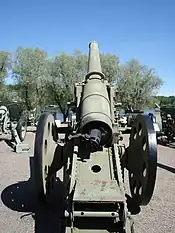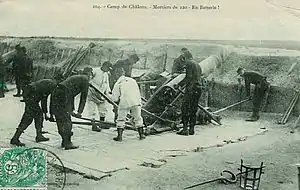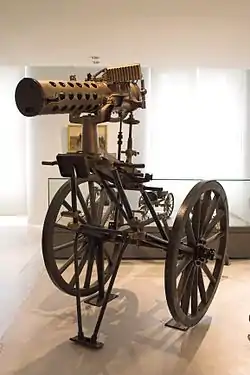Charles Ragon de Bange
Charles Ragon de Bange (17 October 1833 – 9 July 1914) was a French artillery officer and Polytechnician.[1] He invented the first effective obturator system for breech-loading artillery, which remains in use. He also designed a system of field guns of various calibers which served the French Army well into World War I: the Système de Bange.
Charles Ragon de Bange | |
|---|---|
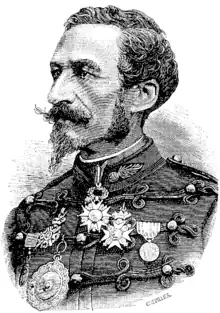 Charles Ragon de Bange. | |
| Born | 17 October 1833 |
| Died | 9 July 1914 (aged 80) |
| Allegiance | France |
| Service/ | French Army (Artillery) |
| Rank | Colonel |
Career
De Bange breech obturator system

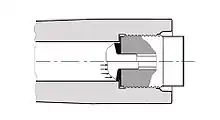
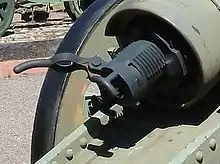

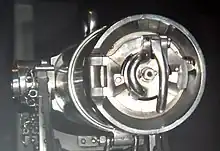
Many attempts had been made at developing breech-loading cannons, but had only partial success sealing of the breech. When fired, hot gases and burning gunpowder could escape, losing power and potentially burning the operating crew. Rifles, with smaller loads and thus less stress, were able to use rubber in O-rings as on the Chassepot rifle. The same principle of breech sealing applied on cannons was not as easy to develop. Several materials were able to hold the pressure and heat of cannon fire, but did not expand like rubber, thereby failing to provide a tight seal. The most successful of those designs was the Broadwell ring invented by American engineer Lewis Wells Broadwell (who worked as a sales agent for the Gatling Gun Company in Europe) in early 1860s and widely applied (without a license) by the Krupp company on their breech-loaders.
In 1872, de Bange designed the de Bange system, a new type of obturating ring for breech-loading artillery pieces. His system utilized the same general principle devised by Andrew Hotchkiss ca. 1855 for his rifled muzzle-loading projectiles, where two parts of the shell squeezed a soft (in that case lead) ring under the pressure of gunpowder fumes to obturate the barrel (see Rotation of ammunition), and used a breech block made of three parts; an interrupted screw locking mechanism at the rear, a doughnut-shaped grease-impregnated asbestos pad that sealed the breech, and a rounded movable "nose cone" at the front. When the gun fired, the nose was driven rearward, compressing the asbestos pad and squeezing it so it expanded outward to seal the breech.[2][3][4] The French referred to the shape of the breech's nose as "mushroom like", as it resembled the cap of a mushroom.
The action was controlled by a handle, normally mounted vertically on the right side of the breech. When lifted, the handle operated a cam that forced the breech to rotate counter-clockwise, unlocking the interrupted thread. The entire breech was then pulled rearward with the same handle, sliding on a ring-shaped holder. The breech holder was hinged on one side, normally the left, so when the breech block was slid all the way to the rear it could be rotated out of the way for loading.
The de Bange system was widely adopted, including by the United States Navy[5] and the British Royal Navy.[6] The technique developed by de Bange is still in use today.[7]
The only major advance on the original de Bange system was the introduction of the stepped screw in the Welin breech block of 1889, which greatly increased the load-bearing surface of the breech, allowing them to be made shorter, simpler, more secure and faster to operate. Other block mechanisms are also used, but the de Bange obturator remains widespread even on these.
Manufacture of cannons
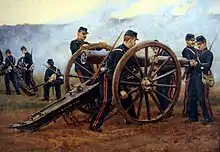

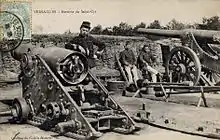
In 1873, de Bange became Director of the "Atelier-de-précision" in the Central Depot in Paris (Paris arsenal's precision workshop),[8] in order to redesign French light and heavy artillery.[9]
Between 1877 and 1881, de Bange developed several artillery pieces, such as the De Bange 90 mm cannon (field artillery, 1877), the De Bange 80 mm cannon (mountain artillery, 1878), the De Bange 120 mm L cannon (siege artillery, 1878), De Bange 155 mm L cannon (siege artillery, 1877), De Bange 155 mm C howitzer (siege artillery, 1881), as well as mortars for siege warfare, such as the 1880 De Bange 220 mm mortar, 1885 De Bange 270 mm and coastal batteries such as the De Bange 240 mm and De Bange 270 mm. Several of these weapons were used during the colonial wars of the end of the 19th century, during the First World War and also sometimes during the Second World War. As with other cannons, the de Bange cannons had the disadvantage of being slow to fire, as they were affected by recoil, and thus had to be re-aimed after every shot. This inconvenience would be solved with the appearance of the famous Canon de 75, that had a hydro-pneumatic recoil mechanism, which kept the gun's trail and wheels perfectly still during the firing sequence. However, there were two howitzers the Obusier de 120 mm C modèle 1890 and Obusier de 155 mm C modèle 1890 with de Bange breeches and recoil mechanisms designed by Captain Louis Henry Auguste Baquet. From 1882 to 1889, de Bange was Director of the Cail Manufacturing Corporation (Société Anonyme des Anciens Etablissements Cail),[10] the forerunner of the Société française de constructions mécaniques, where he worked on weapon design and trade, selling guns to such countries as Serbia.[11]
A street is named after him (Rue du Colonel de Bange) in the city of Versailles.
See also
Gallery
De Bange 155mm cannon (1877)
De Bange 220mm mortar (1880)
References
- New International Encyclopedia 1914 Page 619
- "One of the most efficient obturators not liable to damage is the plastic device introduced by Colonel de Bange of the French service" The Encyclopædia Britannica: A Dictionary of Arts, Sciences, Literature by Hugh Chisholm, p.206
- "The De Bange gas-check, or " pad obturator" is the type used in the U.S. Navy … It is the invention of Colonel De Bange, of France" Naval Ordnance: A Text-book Prepared for the Use of the Midshipmen - Page 66 by Roland Irvin Curtin, United States Naval Academy, Thomas Lee Johnson
- Obturators
- "The De Bange gas-check, or " pad obturator," is the type used in the US Navy for all modern guns that are not rapid-fire." in Naval Ordnance: A Text-book Prepared for the Use of the Midshipmen by United States Naval Academy, United States Naval Institute — Ordnance, Naval - 1915 - Page 66
- "Breech-loading mechanisms". Archived from the original on 2015-01-21. Retrieved 2008-10-29.
- "The De Bange system of sealing the breech of a breech-loading artillery piece was developed by a Frenchman of that name in the late 19th century. The general principle is still in use" The New Weapons of the World Encyclopedia By Diagram Group, Diagram Group Page 352
- The Encyclopedia Americana: A Library of Universal Knowledge (1918), p. 142
- The Encyclopedia Americana p.158
- The New International Encyclopædia edited by Daniel Coit Gilman, Harry Thurston Peck, Frank Moore Colby — Encyclopedias and dictionaries - 1902 Page 429 "From 1882 to 1889 he was director of the Cail corporation"
- Girding for Battle Ingrid A. Sandole-Staroste, Donald J. Stocker, Jonathan A. Grant, p.58


